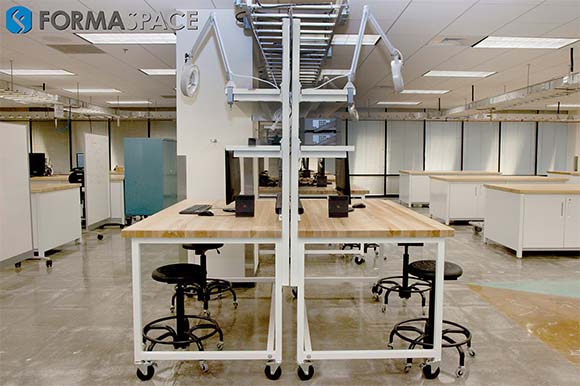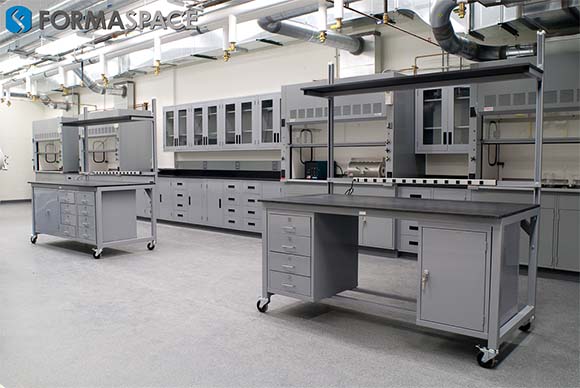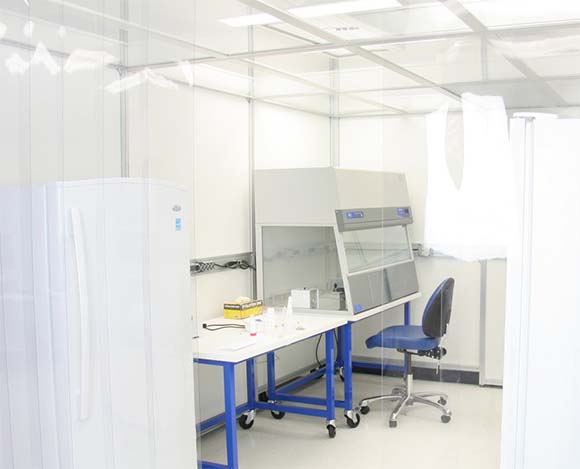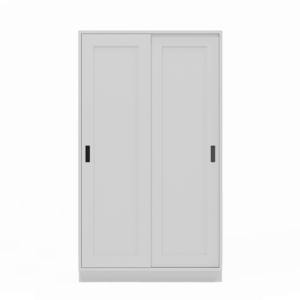In a world focused on making sustainable design choices, many laboratories are falling behind: traditional lab designs can use five times more energy than standard office buildings. But with careful planning, lab architects and facilities managers can create efficient “green labs,” based on sustainable lab design practices that can help close the gap.

Traditional Laboratories Consume High Rates of Energy and Other Resources: Green Lab Design Can Help
Are you concerned about your laboratory’s high energy costs? Do you want to implement sustainable lab design practices in your facility?
You are not alone.
As many facility managers have discovered, laboratories can be stubbornly inefficient when it comes to conserving energy and natural resources.
On a daily basis, traditional laboratories use as much as 5 times more energy than a comparably-sized office, according to the National Renewable Energy Lab, (NREL) located in Golden, Colorado.
Why is this? There are multiple reasons:
- Unlike offices, laboratories are often available for 24×7 access by researchers, and many experimental processes simply cannot be shut down during overnight hours.
- Many types of lab equipment consume energy at far higher rates than equipment typically found in the office. Many experiments generate high levels of heat, which must be dissipated by the HVAC system.
- Safety protocols dictate special considerations for air flow handling and waste removal to prevent exposure to dangerous materials; this often results in costly conditioned air being vented through high-power exhausts rather than recycled through the HVAC system — and water and other chemicals being channeled to isolated drain and treatment systems.
Research needs in the lab can also dictate special requirements that can increase energy use, such as the need to maintain precise control over air or water temperature, the need to maintain electrical power (necessitating the need to install uninterruptible power systems), as well as isolation systems designed to reduce vibration to a minimum for very sensitive experiments.
Tips for Lab Architects Wanting to Create Green Lab Designs
What should lab architects do to create a greener, more sustainable laboratory? Here are three practical suggestions.
1. Clever Design Solutions (Such as Modular Furniture) Can Help Future Proof Your Existing Laboratory
Not everyone has the luxury of moving into a brand new “green” laboratory facility.
One reason is that today’s facility budgets are often tight — especially at a time when limited availability is driving up the cost of leasing new laboratory in the major life science research clusters, such as Boston, New York / New Jersey, or San Diego.
If you feel you’ve outgrown your existing facility, we invite you to take another look.
Remember: the biggest cost saving of all is avoiding the need to move into a new facility.
There are many examples where Formaspace Design Consultants have been able to transform existing facilities into more modern, flexible, and space efficient facilities. For example, we were able to help Craig Venter’s teamwork more efficiently in their quest to be the first to sequence the human DNA by building 150 custom lab furniture carts that could safely move $140k sequencers (each weighing over 400 pounds) in and out of the laboratory without disrupting the ongoing research.
(In the manufacturing arena, Formaspace was able to help a major computer manufacturer avoid spending $84 million on a new facility by making their existing building more space efficient by building custom furniture that doubled the workspace.)
Modular furniture is often the key to creating a more sustainable, greener laboratory. As technology changes, new types of lab equipment are finding their way into research facilities, driving changes in the way experiments are conducted. In turn, many labs require new, efficient floor plan and equipment configurations to accommodate emerging new technologies and new ways of performing research experiments. Using modular lab furniture, which can be reconfigured as your needs change, can help “future proof” your facility investment.

Labs kitted out with traditional fixed casework are difficult to reconfigure without expensive, time-consuming renovation downtime. Modular furniture from Formaspace is different: you can easily reconfigure the stainless steel work surfaces, metal cabinets, shelves, and storage units using simple hand tools — it’s also easy to add new matching benches, shelves, cabinets, etc. as needed. This means you can make changes to your lab floor plans as your needs evolve — such as adding eco-friendly design elements, enlarging lab spaces or dividing existing ones into two — without having to go through a long disruptive renovation.
Modular lab furniture is a sustainable choice in other ways as well. If you ultimately decide to expand to a new location, modular furniture can be reassembled in the new facility without losing your investment (possibly earning you some LEED credits for recycling in the process), while fixed casework lab components may well end up in the solid waste landfill. It’s also important to note that the modular furniture materials themselves, e.g. the stainless steel shelves and work surfaces as well as heavy-duty steel support frames, are also recyclable and can easily be re-purposed for new uses.
2. Sustainable Design Practices Can Save Money by Reducing Waste and Reducing Energy Consumption from the Grid
Given that laboratories typically use five times more energy than comparable office spaces, lab architects and facility planners will want to explore all available options to reduce energy consumption and waste when designing a new laboratory facility (or making major renovations to an existing one).
When possible, green labs are typically oriented on-site to optimize solar gain during the winter while protecting interiors from the summer sun. (Smart sensors can also move sunscreens throughout the day to manage solar gain.) Other green building techniques to consider include incorporating green roofs (equipped with solar panels, white reflective surfaces, or earth-covered), protecting the building from cold northern exposures by building into a hill (or an artificial berm), or installing Subterranean Heating and Cooling Systems (SHCS) that use the latent heat from deep underground to reduce heating and cooling costs.
Super insulation technologies are also fast becoming more mainstream, which has enabled many residential and office facilities to reduce their energy consumption to near zero (Energy Net Zero Building Designs) or even allow them to return surplus energy back to the electricity grid (Energy Net Positive Building Designs).
Can these techniques help green labs achieve energy independence?
The answer is it depends on the type of laboratory.
Dry laboratories (tech labs) which have minimal requirements for vent hoods and other lab-specific safety equipment can come closer to achieving Net Zero and Net Positive levels of energy savings.
However, lab architects designing facilities with cleanrooms and wet labs that require separate, high-power HVAC systems as well as isolated water supply and drains will find it difficult to achieve the same level of energy efficiency as offices or dry labs.

Careful systems design and space planning are critical elements that must work hand-in-hand for a successful, sustainable green lab project. New thinking is required. For example, it may be better to optimize the HVAC, utilities and cleanroom systems for maximum efficiency (and easy maintenance) first before starting the process of space planning the clusters of cleanrooms or wet labs located within them.
This approach can be much more effective than trying to shoehorn complex airflow systems and water/drain stacks into a design that’s already completed.
3. Smart HVAC Systems Can Reduce Energy Consumption in Your Laboratory
Once the laboratory space planning is done, it’s time to take a look at our third recommendation, which is to optimize the individual HVAC system components using modern technology. This step can reduce overall energy usage significantly.
There is a good deal of science backing up the following recommendations. Researchers at the National Renewable Energy Lab (NREL) took on the challenge of modeling the energy consumption of modern laboratories to find the best practices for sustainable lab design.
NREL researchers created sophisticated computer models to analyze the typical energy needs of a 100,000 sq ft building (70,000 sq ft of which is dedicated to laboratory science) in order to calculate the total energy usage for sites located in Atlanta, Denver, Minneapolis, and Seattle.
(The report, titled Laboratories for the 21st Century: Energy Analysis, is available for download as a PDF file.)
According to the report, here are some of the most cost-effective HVAC energy saving strategies that lab architects should consider when planning a new or renovate green lab facility:
- Implement smart control systems that allow the air flow to be reduced when the lab is unoccupied (with the exception of protecting long-running experiments which need conditioned air.)
- Consider moving to a variable-air-volume (VAV) system for fume hoods instead of a constant volume system. This can reduce the need for replacement conditioned air and can save energy by reducing fan usage.
- Energy recovery systems can increase the efficiency of the laboratory and save money. NREL points out that implementing an enthalpy wheel, which uses an intermediate spinning surface to recover latent heat is be the most efficient solution for many use cases, although run-around loops and heat pipes can also be very effective.
- Humidity control is especially costly as well as energy loss from the high ventilation requirements incurred by clean rooms, vent hoods, and other safety systems. As a result, HVAC designers need to work to minimize the pressure drop in the system to save energy.
If you can implement a number of these energy conservation recommendations, it may be possible to specify a smaller HVAC system, which would result in additional savings.
Finally, be creative. For example, the Galveston National Laboratory, which houses one of few BSL-4 laboratories in the U.S., recently installed a weather station that measures prevailing winds. When the winds over the facility increase above a certain speed, the system throttles down some of the high-velocity exhaust stack fans on the roof. This reduces both energy consumption and ambient noise while maintaining a safe level of exhaust dispersion.
Making Sustainable Lab Design a Reality: Real World Examples
Here at Formaspace, we have a lot of experience working with architects developing LEED certified laboratories and hospital facilities.
For example, we were brought in to supply laboratory furniture for the Department of Defense Food Analysis and Diagnostic Laboratory (FADL) at Fort Sam Houston in San Antonio. This sustainable, state-of-the-art laboratory facility is a keystone project in San Antonio’s Fort Sam Houston Sustainable Neighborhood Revitalization and Redevelopment Plan. The new laboratory performs microbiological, chemical, and toxicological tests on the military food supply chain in order to certify it’s safe for DoD personnel. It also provides zoonotic disease monitoring by testing more 8,500 human, animal and arthropod specimens each year in an effort to track disease outbreaks, including testing for rabies, West Nile virus, brucellosis, leishmaniasis, and other public health diseases.

Another recent Formaspace laboratory and hospital project is the award-winning Martin Army Community Hospital located at the Fort Benning U.S. Army Post located between Atlanta, Georgia, and Montgomery, Alabama. This new 745,000 square-foot, state-of-the-art sustainable lab design facility was the Army’s first “design-build” project. The U.S. Army Corps of Engineers led the effort in partnership with Turner Construction and partner AECOM. 3D computerized systems were used in order maximize construction and operational efficiency. The result is a facility that serves a community of more than 90,000 military personnel, family members, and retirees.
Join Us for a More Sustainable Tomorrow

We invite you to work with us on your next green lab project.
As members of the U.S. Green Building Council, we have the expertise and determination to make your sustainable lab design project an overwhelming success.
Take the next step. Contact your Formaspace Design Consultant today. Learn about our full line of sustainable laboratory furniture solutions, featuring options ranging from GreenGuard-certified laminate to recyclable hardwood, stainless steel work surfaces, and heavy-duty steel frames. Just fill out the quick contact form below to get started.











